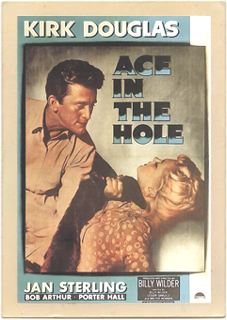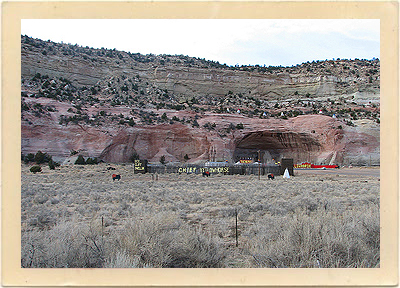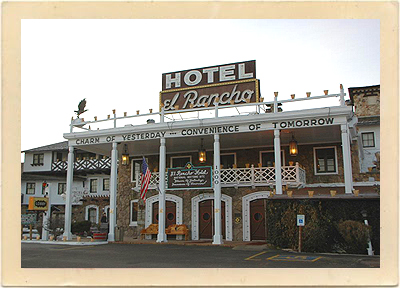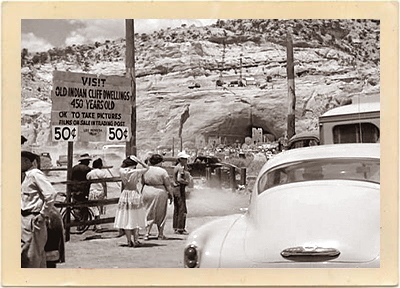 |
|
 Ace in the Hole Ace in the Hole1951. Paramount Pictures, Criterion Collection, Black & White, Aspect Ratio 1.37 : 1, 111 minutes, Not Rated Release Date: June 29, 1951 Ace in the Hole is available at Amazon.com on DVD from the Criterion Collection. Movie Synopsis: A big-city newspaperman with a busted reputation, broke and stranded in Albuquerque, New Mexico, hopes to find his way back to the big time by sensationalizing the rescue of a man trapped in a cliff dwelling cave. Cast: Kirk Douglas, Jan Sterling, Bob Arthur, Porter Hall, Frank Cady, Richard Benedict Director: Billy Wilder Thoughts on the Movie: This offbeat film noir classic is a good example of the kind of movies that were starting to emerge in America in the 1950s: tough, gritty and realistic, and usually shot on location away from the sterility of a Hollywood soundstage. What a wise choice of setting: the absolutely breathtaking red rocks scenery near the New Mexico and Arizona state lines. I have traveled through this area a number of times in my life, and upon seeing it once again, it never fails to amaze me. The beauty and grandeur of this area of the Southwestern United States has to be seen (in real life) to be believed. With this backdrop, the mundane reality of the characters sits like a dull thud, as it should, amongst such splendid natural scenery. Even though this film was shot in black and white, the essence of the location still comes across, but more like a stoney, speechless character among the animate actors who move the drama from start to finish. This has always been amongst my favorite “late night TV” movies, but now it can be seen in all its glory in a newly remastered version from the Criterion Collection. Bravo! ~Jean  Location Site: Location Site:Gallup, New Mexico (see Map) The rescue effort (which is the bulk of the movie) takes place at the Cliff Dwelling site in the Gallup area. However, you won’t actually be able to follow the trail to the old Indian Cliff Dwellings at the fictitious “Minosa Trading Post” where Leo Minosa was trapped. Right: This is the location that was used for the Indian Cliff Dwellings scenes in "Ace in the Hole." The then-active, real life trading post sits in front of the beautiful red rock formation. The film used a gigantic set, claimed at the time to be the largest constructed for any movie other than a war film (it cost $30,000). Towering 237 feet into the air and covering an area 1,200 by 1,600 feet, it incorporated the Cliff Dwellings, the Indian settlement and the ensuing carnival. The set was located behind the Lookout Point Trading Post on US Route 66, west of Gallup. After filming was completed, the set was left intact and the owner of the trading post used it to draw tourists to his store. You can still visit the breathtaking New Mexico desert where the mammoth set was built near Manuelito, about 20 miles west of Gallup on I-40, on the Arizona border. (I-40, incidentally, is part of the old Route 66.) About Gallup, New Mexico:  Gallup, New Mexico (population 20,209; elevation 6,515 feet; 35° 31’ 25” N, 108° 44’ 3” W) lies in a red rock mesa region in the northwest part of the state, directly on I-40. The real star attraction of Gallup is the natural scenery: some of the most breathtaking and huge red rock formations can be found in the area. Gallup, New Mexico (population 20,209; elevation 6,515 feet; 35° 31’ 25” N, 108° 44’ 3” W) lies in a red rock mesa region in the northwest part of the state, directly on I-40. The real star attraction of Gallup is the natural scenery: some of the most breathtaking and huge red rock formations can be found in the area.Right: The “main drag” of Gallup, New Mexico, circa the 1980s. Notice the motel price of “two for $26.99” at the Arrowhead Lodge. For travelers coming from the west, the Gallup landscape is what hits you upon crossing the Arizona border, and believe me, it is unforgettable. It has one coming to grips with concepts such as “there must be something bigger than myself” and “how was this world made?” It’s just that powerful. And yet, the Indian tribes and Hispanic peoples who have lived in the area for generations somehow deal with the grandeur of the setting and simply get on with their daily lives. Billed as the “Gateway to Indian Country,” Gallup is best known as the main trading center for most Navajo Indians (whose vast reservation extends north and west into Arizona) and the Zuni Pueblo, as well. “Historic Gallup” on old Route 66 has a downtown walking tour. Nearby Attraction: Red Rock State Park Eight miles east of Gallup on I-40, Church Rock, New Mexico. The focal point is the 6,800-seat rodeo arena in a natural amphitheater at the base of red sandstone cliffs. Two nature trails are available, and Indian dances are performed daily at 7:30 p.m. from Memorial Day through Labor Day. The Red Rock Museum displays artwork and crafts of the Southwest Indians. Lodging & Dining:  El Rancho Hotel. From I-40, exit 22, 1000 US 66 E or Business Loop 40, Gallup, New Mexico. El Rancho Hotel. From I-40, exit 22, 1000 US 66 E or Business Loop 40, Gallup, New Mexico.This three-story hotel is one of the most colorful lodges in the Southwest. Built by R.E. Griffith (brother of film director D.W. Griffith) in 1937, it quickly became a home-away-from-home for Hollywood celebrities working on the many movies filmed in the area. The walls of the second-floor railed balcony are adorned with autographed black and white glossies of the stars who have stayed here. Among them: James Stewart, Kirk Douglas, Henry Fonda, Lee Marvin, and James Cagney. The 100 rooms are named after the people who have stayed in them: the W.C. Fields Room, the Marx Brothers Room, the Katherine Hepburn Room, and the Ronald Reagan Room, among many others. The El Rancho Motel (1020 US 66 E) is next to the hotel. The El Rancho Restaurant (in the El Rancho Hotel) serves good, down-home meals at reasonable prices. Mexican classics such as enchiladas, tamales, tacos, and chile rellenos are on the menu, along with American fare such as steaks, ribs, and burgers. Also, the 49er Lounge at the El Rancho is known for serving some of the best Margaritas around and has one of the most extensive Mexican beer lists in the area.  Awards: Awards:• Jan Sterling won the National Board of Review Award for Best Actress. • Billy Wilder, Lesser Samuels and Walter Newman were nominated for the Oscar for Best Writing, Story and Screenplay. Right: A scene from the film which depicts the grotesque “carnival” phase of the mine disaster, as tourist pour into the site. Movie Trivia: • The original title of Ace in the Hole, was changed to “The Big Carnival,” because it was considered “too cynical.” By more modern standards, the second title might seen more cold and heartless, with the anti-commercialism sentiment that is popular today. With the Criterion Collection re-release of this gem on DVD, the original name has been restored, although there are most likely some prints still in existence that bear the opening title of “The Big Carnival.” • Politically incorrect by today’s standards, the film is peppered with racial and regional prejudice. Douglas’ first line in the movie is to a Native American employee at an Albuquerque newspaper office: he greets him with, “How.” • The production used 1,500 Gallup extras in the huge crowd scenes. They were paid 75¢ an hour for a ten-hour day. Extras earned an additional three dollars if they could bring an automobile to the set. Character Quote: “You know what’s wrong with New Mexico? There’s too much outdoors.” ~Charles Tatum (Kirk Douglas) |
|